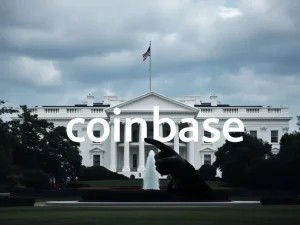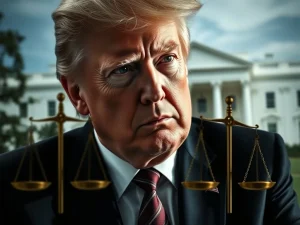CBDC Ban: US House’s Pivotal Move to Block Digital Dollar

The cryptocurrency world is watching Washington closely. The US House of Representatives is making a pivotal move. They may soon fast-track a comprehensive CBDC ban. This action aims to prevent the Federal Reserve from issuing a central bank digital currency. The House plans to combine this ban with an existing market structure bill. This legislative maneuver could significantly impact the future of US crypto regulation.
The Strategic Push for a Federal Reserve CBDC Ban
The US House of Representatives is actively seeking a shorter legislative path. This path aims to prohibit the Federal Reserve from issuing a central bank digital currency (CBDC). Lawmakers are considering a strategic move. They propose integrating the text of the Anti-CBDC Surveillance State Act into the Digital Asset Market Clarity Act. This combination forms a robust market structure bill. The House Rules Committee recently reviewed this proposal. A draft agenda highlighted the plan. This engrossment method would add the CBDC bill to the final version. It would then send the combined legislation to the Senate for consideration. This action underscores a strong desire among some lawmakers to prevent a Federal Reserve CBDC from becoming a reality.
This legislative strategy is not entirely new. House Republicans explored a similar approach earlier this year. Before a July floor vote on the GENIUS Act, some lawmakers sought to include a CBDC ban. The GENIUS Act focused on regulating payment stablecoins. This earlier attempt aimed to slow its passage before the chamber’s August recess. Ultimately, all three individual bills — the Anti-CBDC Surveillance State Act, the Digital Asset Market Clarity Act, and the GENIUS Act — passed with some bipartisan support. The current effort to combine these bills reflects an intensified focus on preempting a government-backed digital currency. This decisive action could reshape the landscape of digital finance in the United States.
Advancing US Crypto Regulation Through Combined Legislation
The proposed combination of these key bills marks a significant step. It aims to advance US crypto regulation. The Digital Asset Market Clarity Act seeks to provide much-needed regulatory guidelines. It addresses the classification and oversight of digital assets. By attaching the Anti-CBDC Surveillance State Act, the House reinforces its stance. It clearly opposes a central bank digital currency. This legislative packaging creates a comprehensive framework. It defines both market rules and limits on government digital currency issuance. This approach streamlines the legislative process. It also presents a unified front on crucial crypto policy issues.
Key aspects of this combined legislation include:
- Retroactive CBDC Ban: The bill proposes a ban that would apply retroactively. This means it would prohibit a CBDC even if prior steps had been taken.
- Market Structure Framework: It establishes clearer rules for digital asset markets. This provides certainty for innovators and investors.
- Expedited Passage: Combining bills into a single package can accelerate its journey through Congress.
- Congressional Authority: This move asserts Congress’s role in shaping the future of digital finance. It limits the executive branch’s power over monetary policy.
This legislative tactic reflects a growing consensus among some lawmakers. They believe robust regulation and clear boundaries are essential. These elements are vital for the healthy development of the digital asset industry. The proactive stance on the CBDC ban highlights concerns about privacy and government overreach. Many critics fear a CBDC could enable extensive surveillance. Consequently, this combined bill addresses both market clarity and fundamental concerns about digital monetary control.
Senate’s Distinct Path for the Market Structure Bill
While the House pushes its combined bill, the Senate pursues a distinct legislative path. It is unclear whether the engrossed House bill, combining market structure and a CBDC ban, will influence the Senate’s version. Republicans on the Senate Banking Committee have developed their own framework. They refer to it as the Responsible Financial Innovation Act. This legislation, while building on the CLARITY Act, is a distinct proposal. Senator Cynthia Lummis of Wyoming is a key backer of the Senate’s market structure bill. She expects the banking committee to pass the legislation by the end of September. She even suggested that US President Donald Trump could sign it into law by 2026. However, at the time of publication, no vote had been scheduled with the banking committee. This indicates potential delays or ongoing negotiations within the Senate.
The Senate’s approach differs in name and potentially in scope. Both chambers aim for regulatory updates. However, the specifics of their proposals may vary. This divergence could lead to challenges in reconciliation. Ultimately, any final legislation would need to pass both chambers. It would also require presidential assent. The Senate’s independent progress highlights the complexity of achieving unified US crypto regulation. Each chamber navigates its own political and procedural landscape. Consequently, the journey for comprehensive digital asset legislation remains intricate and subject to ongoing debate.
Seeking Digital Asset Clarity Amidst Political Divides
Achieving comprehensive digital asset clarity requires broad support. Republicans currently hold slim majorities in both the House and Senate. Therefore, some bipartisan cooperation will be necessary for successful legislation. Both parties have proposed frameworks to update regulatory requirements. These proposals aim to provide much-needed clarity for the digital asset industry. However, significant differences persist. Democrats, for example, have called for specific provisions. They seek to address what they describe as Trump’s ‘undermining confidence in the broader digital asset industry.’ This refers to Trump’s family crypto ventures.
Democrats’ concerns specifically highlight Trump’s ties to the industry. These include his family’s mining venture, American Bitcoin, World Liberty Financial, and his personal memecoin. Whether Republicans intend to address these specific ties within the combined bill remains unclear. Such provisions could complicate bipartisan negotiations. They might also slow the passage of crucial legislation. The political landscape around crypto is complex. It involves both policy goals and partisan interests. Therefore, finding common ground on regulatory clarity, while addressing ethical concerns, is a significant challenge. The bill is expected to head for a committee vote within two weeks, indicating that these debates are reaching a critical juncture.
The Future Impact on a Federal Reserve CBDC and the Industry
The potential for a congressional CBDC ban carries significant implications. Such a ban would fundamentally alter the trajectory of digital currency in the United States. It would cement a policy decision against a government-issued digital dollar. This decision could have profound effects on financial innovation. It might also influence the competitive landscape for private stablecoins and other digital assets. A clear prohibition on a Federal Reserve CBDC would remove a layer of uncertainty for the crypto industry. It would allow companies to innovate without the looming threat of a direct government competitor.
Furthermore, this legislative action could set a precedent. It would underscore the role of Congress in defining monetary policy in the digital age. It emphasizes a preference for market-driven solutions over centralized digital currencies. For the broader digital asset industry, this push for a combined market structure bill is critical. It aims to provide clear rules of the road. This clarity can foster greater investment and development within the sector. It could also enhance consumer protection. Ultimately, these legislative efforts reflect a crucial moment. Policymakers are grappling with the rapid evolution of digital finance. They seek to establish a regulatory framework that balances innovation, stability, and individual liberties.







